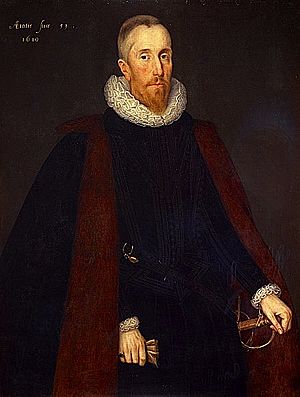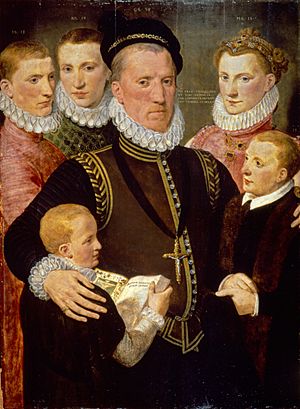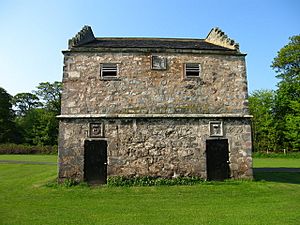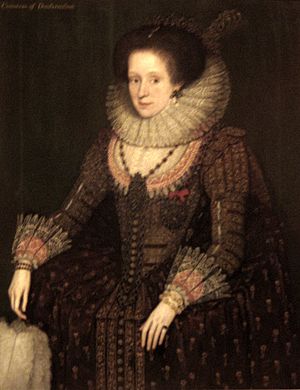Alexander Seton, 1st Earl of Dunfermline facts for kids

Alexander Seton, 1st Earl of Dunfermline (born 1555, died 1622) was an important Scottish lawyer, judge, and politician. He held several high-ranking jobs. From 1598 to 1604, he was the Lord President of the Court of Session, which is like the head judge. Then, from 1604 until his death in 1622, he served as the Lord Chancellor of Scotland, a very powerful government role. He also represented the King in the Scottish Parliament as a Lord High Commissioner to the Parliament of Scotland.
Contents
Growing Up: Alexander Seton's Early Life


Alexander Seton was born in Seton Palace, East Lothian, Scotland. His parents were George Seton, 7th Lord Seton, and Isobell Hamilton. His family remained Roman Catholic even after the Scottish Reformation in 1560. This was a time when Scotland largely became Protestant. The Seton family continued to support Mary, Queen of Scots, even after she gave up her throne and went to England.
Alexander went to school in Rome, Italy, from 1571 to 1578. He was known for being good at languages, especially Italian. He also studied science and philosophy. Some people believed he was so smart that he might have become a Cardinal if he had stayed in Rome. He even earned a special degree from the University of Bologna.
Alexander Seton's Career and Rise to Power
In 1583, Alexander Seton traveled to France with his father. He became a Privy Councillor in 1585. This meant he was a trusted advisor to the King. In 1586, he was appointed a judge in the Court of Session, known as Lord Urquhart. He quickly moved up the ranks.
By 1598, he became the Lord President of the Court of Session, the highest judge in Scotland. He was also given the title Lord Fyvie. From 1593, he helped manage the lands of Anne of Denmark, who was the Queen. She later made him in charge of her lands around Dunfermline. People noticed that Alexander's mother was very close to Queen Anne. This connection helped Alexander get promoted.
King James VI sometimes struggled to pay for his royal households. Alexander Seton once joked that the King's house couldn't be run on "fine words alone." This meant they needed real money, not just promises.
Alexander Seton was seen as a very important person in the King's court. He was known for his strong legal mind. In 1598, he became the leader of Edinburgh, called the Provost of Edinburgh. He helped arrange important events, like banquets and royal baptisms.
The Union of the Crowns and Seton's Influence
Alexander Seton was one of the smartest legal experts of his time. He became a key advisor to King James VI. He also became a guardian and teacher to Prince Charles, who was then called the Duke of Albany.
When Queen Elizabeth I died in 1603, King James VI became King of England too. This event is called the Union of the Crowns. The Scottish royal family moved to London. However, Alexander Seton stayed in Scotland to help manage Queen Anne's money. Young Prince Charles stayed with Seton and his wife, Grizel Leslie, at Dunfermline Palace.
In 1604, Seton wrote a letter about the Union of the Crowns. He said that most people in Scotland were happy about the idea of the two countries joining. He believed that what was good for one country would also be good for the other.
Later in 1604, Alexander Seton was made Lord Chancellor of Scotland. This was a very powerful position. In 1605, he was given the title Earl of Dunfermline. He then brought Prince Charles to England. They traveled with a large group of people.
Seton stayed in London for a while. He visited the Tower of London and saw old historical documents. He returned to Scotland with a special payment from the King. He also became friends with the Venetian ambassador, who sent him news about politics.
In 1606, Seton wrote about the plague in Scotland. It had been in Edinburgh for four years. He said it was affecting the law courts and had caused many deaths in other towns. After another important person died, Seton was put in charge of Holyrood Palace and its gardens.
In 1611, he helped a French clockmaker named Nicolas Foucanote settle in Edinburgh. Seton helped him become a citizen by arranging his marriage to a local woman. In 1616, Seton visited Queen Anne in England. He felt that Scottish people were not as involved in government decisions as they should be.
Before King James visited Scotland in 1616, Seton had to report what was left of the royal tapestries at Dunfermline Palace. He listed old and worn tapestries showing stories like Aeneas and Troy. Seton was also known for defending a woman accused of witchcraft in 1614. This showed his modern way of thinking.
Alexander Seton's Homes and Interests

A painting of his wife, Margaret Hay, was made in 1615 by Marcus Gheeraerts the Younger. It is now in a museum in New Zealand. At his home, Pinkie House, there is a special painted ceiling with his initials and family symbols. His long gallery at Pinkie House is still there today. People said he built a "noble house" with beautiful stone walls around the gardens.
The gallery at Pinkie House has a wooden ceiling painted with pictures and sayings. These paintings might have celebrated the Union of the Crowns. Seton also had a home in Edinburgh. His will listed valuable tapestries and leather wall hangings. He also owned fancy jewelry, including a gold swan with diamonds and rubies.
Seton had a large library. In 1599, a book about counting years was dedicated to him. The author called him a "rare Maecenas," meaning someone who supports artists and writers. In 1617, John Napier, who invented "Napier's bones" for calculations, also dedicated his book to Seton.
Alexander Seton also paid for the tomb of his friend, the architect William Schaw, at Dunfermline Abbey.
Death and Funeral
Alexander Seton passed away on June 16, 1622, at Pinkie House, after being sick for 15 days. His nephew stayed by his side for 12 days.
On June 19, his body was taken by boat to his house near Dunfermline. He was buried in his family tomb at Dalgety Church on July 9, 1622. A detailed description of his funeral procession still exists. It included his stable master riding in armor and his household master carrying a black flag.
Family Life: Marriages and Children

Alexander Seton was married three times and had several children.
His first wife was Lilias Drummond. Their children were:
- Anne Seton (born around 1593), who married Alexander Erskine.
- Isobel Seton, who married John Maitland, 1st Earl of Lauderdale.
- Margaret Seton (born 1596), who died as a baby.
- Margaret Seton (born 1599), who married Colin Mackenzie, 1st Earl of Seaforth.
His second wife was Grizel Leslie, whom he married in 1601. Their children were:
- Charles, who died young.
- Lilias Seton (born 1602).
- Jean Seton (born around 1606), who married John Hay.
His third wife was Margaret Hay, whom he married around 1607. Their children were:
- Charles Seton, 2nd Earl of Dunfermline.
- Grizel Seton (born 1609).
- Mary Seton (born 1611).
After Alexander Seton died, his widow Margaret Hay later married James Livingston, 1st Earl of Callendar, in 1633.
See Also
- List of Lord Chancellors of Scotland
- List of Lord Presidents of the Court of Session

